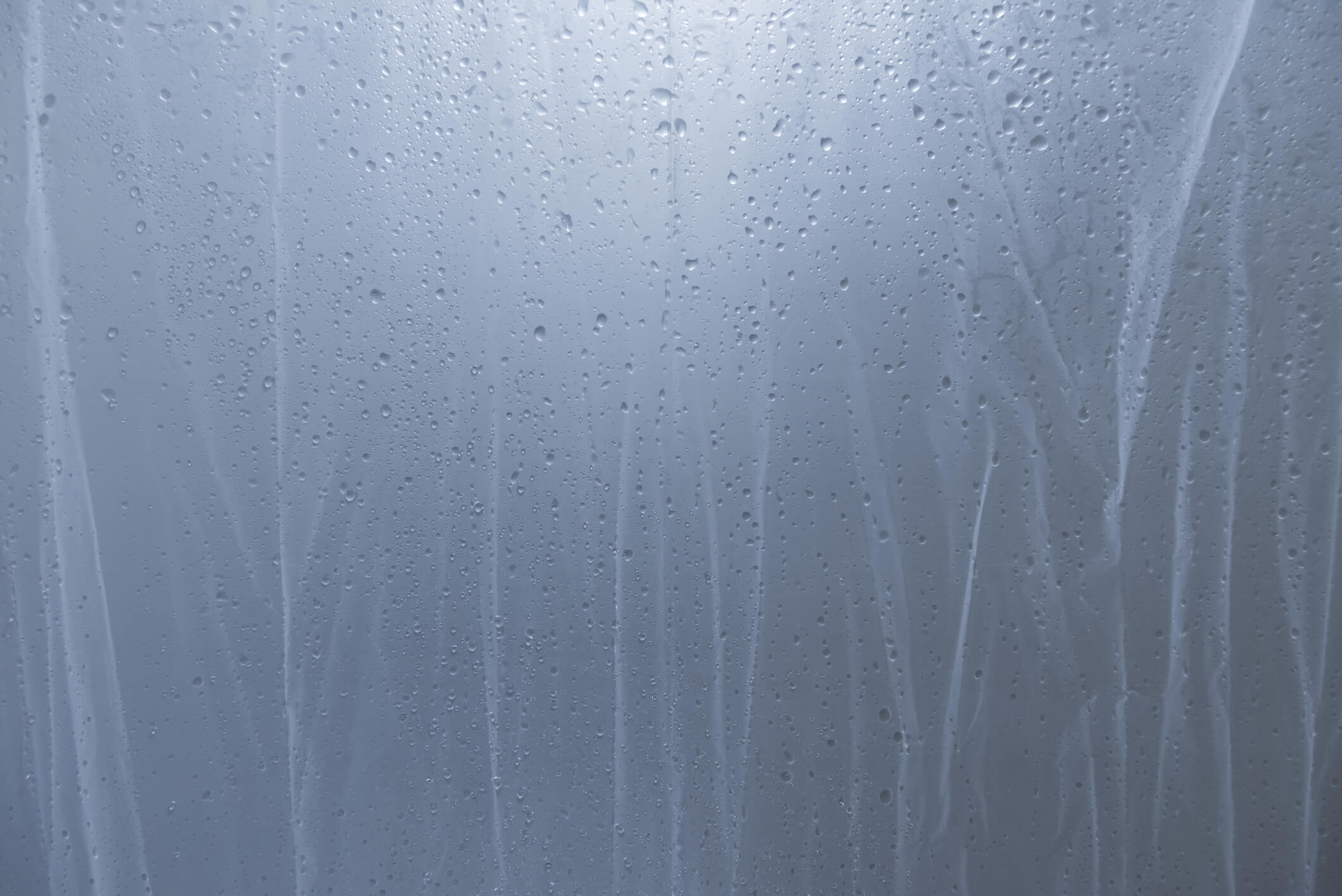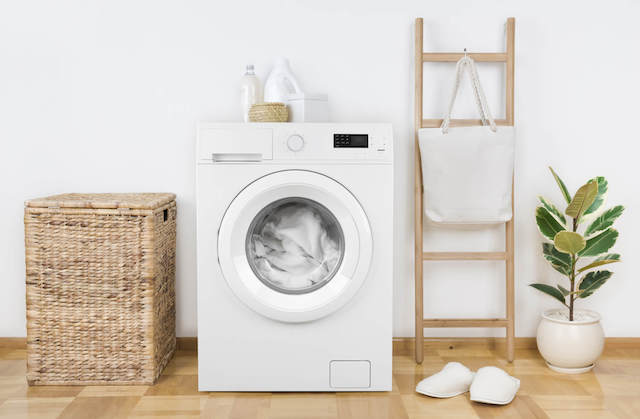There you are, minding your own business and getting through your shower routine when you look down and… what is that funk at the bottom of the tub? It’s probably safe to say that we’ve all been there and experienced this particular ick situation. Unfortunately, that fungus among us is seriously in love with our bathrooms, and can easily lead to issues like mold on a shower curtain.

But, just because we’ve all experienced a moldy shower curtain doesn’t mean we should continue the trend! No one wants to shower alongside this indoor contaminant. Not only is it high on the yuck factor, but it’s also not great for our ongoing health and wellbeing. Which is not exactly on the list of benefits we were looking for when hopping in for some cleansing sudsy time.
Actively taking steps to prevent mold on a shower curtain can ensure your bathroom routine remains the refreshing experience you want it to be and is not crashed by a certain persistent fungus.
Here’s what you need to know.
That Fickle Little Thing Called Mold
Before getting into the how of preventing mold on a shower curtain, it’s best to know why you’re taking all of these extra steps. That means getting to know this fungus among us. “Know thy enemy,” and whatnot so that it doesn’t feel welcome in your bathroom.
Mold Fast Facts
So far, over 100,000 species of mold have been identified so far, meaning that the colorful growth on your curtain could be any number of moldy varieties. Each species reproduces by creating microscopic spores and releasing them into the surrounding area.¹’² Keep in mind that these tiny specks are invisible to the naked eye.
Like seeds, these little spores will remain non-living particles and continue floating around on the air current, bouncing from surface to surface. They won’t transition into a living organism (a mold colony) until they land on a surface with all of the ingredients necessary for life. Thanks to their hardy nature, mold spores only need two main components to begin living.³
These components are:
- A food source
- A moisture source
If these two boxes are checked off for 24-48 hours, a mold spore can put down roots called hyphae onto the surface it’s growing on and restart that reproductive process. Again, just like a normal plant.
Why Does Mold on a Shower Curtain Occur?
As most of us know, mold on a shower curtain can happen quickly and easily (if steps aren’t taken to prevent it). When you think about it, mold’s love affair with these items makes sense.
Water is an easy checkmark. Whether you’re a daily or every-other-day shower-er, one of the main components of this cleanly time is H2O. Not to mention, flushing the toilet, taking a bath, and running the sink faucet add even more moisture to the bathroom by throwing water particles into the surrounding air.

Basically, if a little spore zipped in through the bathroom door and landed on the shower curtain, it will think it won the lottery dream home. And, thanks to their small size, the little particles can make their way inside a home at any time. Hence why prevention is so important so that these particles are actively removed before they turn into a colony and the potential health effects of exposure don’t take hold.
The Impact of Indoor Mold Exposure
Mold on a shower curtain or anywhere indoors has the potential to cause serious problems. As mentioned above, when a colony develops, it starts to release microscopic spores into the surrounding environment. Some species of mold also create and release microscopic toxins called mycotoxins when they feel threatened.⁴
All of these tiny particles are one of the main issues of indoor mold growth. You might be thinking, okay but mold is everywhere so why is it a problem when it’s on my shower curtain? True, mold growth occurs all over the world. The difference is that when this growth happens outside, all of those particles have the big, wide world to disperse through.
When mold on a shower curtain occurs, most of those particles remain inside the bathroom or circulate throughout the rest of the home. Remember, they’re small enough to catch the air current and zip anywhere and everywhere.

Why are they stuck in your home? Thanks to modern building practices pushing for net-zero energy efficiency, there’s very little airflow between indoor and outdoor spaces, meaning that as long as that colony is thriving and surviving, those particles will continue to build up inside. This tanks the indoor air quality, contaminants surfaces, and can wreak havoc on your health.
Again, their size is what gives them their ability to cause problems. Measured in a unit called microns, mold spores, mycotoxins, and other related particles (bacteria often love to join the particle party and will grow right alongside mold) are tiny enough to be inhaled, ingested, and absorbed into our bodies. The EPA classifies them as particulate matter and breaks them down into two categories.⁵
These two categories are:
- PM10: particles that have a diameter of around 10 micrometers or less.
- PM2.5: fine particles that have a diameter of around 2.5 micrometers or less.
The longer you’re exposed to this indoor growth, the more and more particles will enter your body. Each particle is then tagged by the body as a foreign invader, triggering an immune response in an effort to get rid of it. This is where things can get a little wonky.⁶’⁷’⁸’⁹’¹⁰ The immune system can get overloaded and/or malfunction, resulting in a long list of potential symptoms and related health conditions like Chronic Fatigue Syndrome, Aspergillosis, and Mast Cell Activation Syndrome.

A few symptoms of exposure include:
- Headaches
- Brain fog
- Chronic fatigue
- Mood swings
- Anxiety and depression
- Muscle and joint pain
- Rashes
- Hair loss
- Respiratory problems
- Runny nose
- Digestive issues
The tricky thing is that no two people respond the same way to exposure for a variety of reasons. One individual may have the occasional recurring headache while another develops an autoimmune condition and over 40 symptoms. This makes research and the initial diagnosis difficult.
Some of the factors influencing exposure responses include:
- Genetics: Some individuals are predisposed to be more sensitive to mold exposure. For example, a few studies have started linking those with the HLA-DR as hypersensitive because their body’s immune system does not respond properly to toxins such as mycotoxins.¹¹’¹²
- Immune system status: Those with a compromised or developing immune system can not keep up with the onslaught of foreign particles as well as those with a healthy immune system can. Oftentimes, they’ll experience adverse health reactions faster and to a greater extent.
- Presence of mycotoxins: These tiny toxins can pack a punch and a growing body of research points to the long list of symptoms they can cause. Interestingly, while mycotoxins are regulated in our food, they are not regulated in our indoor environments.
- Length of exposure: The longer an individual is exposed, the more particles enter the body. This can eventually lead to an overloaded immune system, adverse health reactions, and toxic buildup.
- Volume of exposure: Similar to length of exposure, if there’s a significant amount of colonized mold within a home, that is directly related to a higher number of foreign particles entering the body. This event can also lead to toxic buildup and adverse health reactions.
Any reaction is enough of a reason to actively work to prevent issues such as mold on a shower curtain. The more mold growth we can avoid, the healthier our indoor environments will be and the more they’ll support our ongoing wellbeing.
How to Prevent Mold on Shower Curtain
Preventing mold on a shower curtain is all about eliminating any spores that managed to make their way inside of your bathroom and ensuring they don’t have the necessary components for growth.
Steps to prevent mold on a shower curtain include:
1. Clean the liner, curtain, rod, and rings once a month
Cleaning every part removes any particles present, including food sources and spores.
For all parts, check the manufacturer’s instructions for their suggested cleaning methods.
Typically, though, you can throw the liner in the washing machine using cold water and EC3 Laundry Additive. This botanical cleaner helps pull particles from the surface and eliminate them (plus it helps keep the washing machine mold-free). Air dry completely when it’s finished. Wash the curtain using a similar method and allow it to dry completely before placing it back on the rod.
For the shower rod, spray it with a botanical cleaner like Benefect Decon 30 or white vinegar, and then wipe it with a microfiber cloth. These are 100 times better at removing small particles than normal rags.

As for the rings, soak them in a mixture of white vinegar and water for 10-15 minutes, wipe with a microfiber towel, and then allow them to dry completely before placing them back on the rod.
2. Separate the liner and curtain
After you shower, make sure to place the shower liner inside the tub and the shower curtain outside the tub so that both materials can dry properly. Separating them helps prevent moisture from getting trapped between them. Again, all it takes is 24-48 hours on a wet surface for mold to start growing.
3. Maintain the indoor humidity between 35-50 percent
High humidity can lead to mold growth, so aim to keep the humidity level in the bathroom around 35-50% to discourage growth.¹³ Focusing on bathroom airflow can help, either by cracking a door or window and turning on the exhaust fan while showering. If the humidity won’t lower to the right level, consider investing in a dehumidifier to remove that excess moisture.
4. Deep clean the bathroom
Like cleaning the shower curtain, regularly tackling the entire bathroom can help remove unwanted particles and contaminants. You’ll need a HEPA vacuum cleaner, botanical cleaning products like Benefect Decon 30 and 8% hydrogen peroxide, and microfiber towels.
Don’t forget porous items in the bathroom as well, including bath mats and towels, which can be washed with EC3 Laundry Additive.
5. Keep the entire space dry
There are several steps to help keep the bathroom dry.
These include:
- Hanging up the shower mat and towels after use
- Wiping up pooled water
- Squeegeeing the shower after use
- Focusing on airflow
6. Regularly Check For Mold
Make sure to take a close look at the shower curtain, liner, rod, and rings as well as other moldy hotspots in the bathroom. These can include the toilet tank, grout and caulk, underneath the sink, and the toothbrush. The sooner you catch a problem, the faster you can address it and the less contamination there will be in your bathroom.
Collectively, these steps will keep help prevent mold on a shower curtain and keep your bathroom healthy.
How to Get Rid of Mold on a Shower Curtain
The best way to deal with mold on a shower curtain is to throw it in the trash outside, start fresh with a new one, and deep clean the bathroom.
With mold’s ability to grow roots and the tiny size of the particles created, it can be difficult to completely remove all of the contamination from porous items. In order to ensure no adverse health effects develop, all of the pesky particles must be removed.
That’s why bleach should never be used to handle any moldy problem because it can leave behind particles like dead mold. Even the EPA states that dead mold can trigger adverse health reactions so the whole shebang has got to go, mold roots, dead particles, spores, mycotoxins, bacteria, and all.¹⁴

Deep cleaning the bathroom takes this a step further by removing any of the particles released by the active colony so that they can’t opportunistically start to grow elsewhere in the bathroom or home. Thoroughness is the name of the game when it comes to dealing with indoor mold growth.
How Do You Know if You Have a Moldy Shower Curtain?
Seems like a no-brainer, right? Just take a look and see if there’s a problem. That’s not quite true. Checking for a problem involves using multiple methods.
See Anything Icky?
Obviously taking a look at the item in question can help alert you to mold on a shower curtain fiasco. With so many species out there, mold can come in all sorts of colors, shapes, and textures, so look for any sort of abnormality. Some of the most common colors include green, white, grey, blue, red, black, brown, or the infamous pink. As for textures, they could be fuzzy, powdery, velvety, or slimy.
Any little patches of growth indicate a problem and should be tackled ASAP.

Give it a Sniff
If you don’t find any visible mold, that doesn’t mean that there isn’t a problem. Thanks to a mold spore’s small size, growth can go on for some time before the particles are large enough to be visible to the naked eye.
In this case, rely on your nose. Mold growth often creates a damp, musty, earthy smell due to the release of gases called microbial volatile organic compounds (MVOC).¹⁵ If your sniffer picks this up, err on the side of caution and get started on remediation.
Check-In With Your Body
To make matters more tricky, not all mold growth will be visible, and not all mold growth will create a smell. Talk about a pain, right? In cases like this, pay attention to your body and how you feel. Have you developed chronic symptoms? Do they flare up in the bathroom or while showering?
Our bodies are amazing warning systems that will let us know when something is wrong. If you start feeling unwell, those invisible particles could be making their way inside of your body and wreaking havoc, causing your body to sound the alarm and push for you to get out of that situation. Always listen to your body when it’s saying, “Hey this is definitely not a great situation.”
Saying No to Showering With Mold
Taking a shower is supposed to be all about self-care and relaxation. You can’t really relax, though, when you’re standing next to mold on a shower curtain and the particle party that comes along with it. Your body definitely doesn’t appreciate this situation!
Keeping that shower curtain in tip-top shape is just one step towards living healthier and happier lives. We may not consider preventing mold as steps toward improving our health, but it should absolutely be a part of our wellness plan! Our indoor spaces play a huge role in our overall wellbeing.
Health begins at home.™

Citations:
- Environmental Protection Agency. (n.d.). Mold. EPA. Retrieved from https://www.epa.gov/mold.
- Centers for Disease Control and Prevention. Basic facts about mold and dampness. Centers for Disease Control and Prevention. Retrieved from https://www.cdc.gov/mold/faqs.htm.
- Lstiburek, J., Brennan, T., & Yost, N. (2002, January 15). Rr-0208: What you need to know about mold. Building Science Corporation. Retrieved from, https://www.buildingscience.com/documents/reports/rr-0208-what-you-need-to-know-about-mold/view.
- World Health Organization. (n.d.). Mycotoxins. World Health Organization. Retrieved from https://www.who.int/news-room/fact-sheets/detail/mycotoxins.
- Nchh. (n.d.). Mold. NCHH. Retrieved from https://nchh.org/information-and-evidence/learn-about-healthy-housing/health-hazards-prevention-and-solutions/mold/
- EPA. (n.d.). Health and Environmental Effects of Particulate Matter (PM). EPA. Retrieved from https://www.epa.gov/pm-pollution/health-and-environmental-effects-particulate-matter-pm.
- Curtis, L., Lieberman, A., Stark, M., Rea, W., & Vetter, M. (2004). Adverse health effects of indoor molds. Journal of Nutritional & Environmental Medicine, 14(3), 261-274.
- Bush, R. K., Portnoy, J. M., Saxon, A., Terr, A. I., & Wood, R. A. (2006). The medical effects of mold exposure. Journal of Allergy and Clinical Immunology, 117(2), 326-333
- Fisk, W. J., Lei-Gomez, Q., & Mendell, M. J. (2007). Meta-analyses of the associations of respiratory health effects with dampness and mold in homes. Indoor air, 17(4), 284-296.
- Wild, C. P., & Gong, Y. Y. (2010). Mycotoxins and human disease: a largely ignored global health issue. Carcinogenesis, 31(1), 71-82.
- Environmental and Occupational Health Assessment Program, & Environmental and Occupational Health Assessment Program, & Health Science Section, Mold Basics for Primary Care Clinicians (2009). Hartford, CT; Connecticut Department of Public Health. , H. S. S., Mold Basics for Primary Care Clinicians 1–10 (2009). Hartford, CT; Connecticut Department of Public Health.
- Chauhan, B., Santiago, L., Kirschmann, D. A., Hauptfeld, V., Knutsen, A. P., Hutcheson, P. S., ... & Bellone, C. J. (1997). The association of HLA-DR alleles and T cell activation with allergic bronchopulmonary aspergillosis. The Journal of Immunology, 159(8), 4072-4076.
- Knutsen, A. P., Vijay, H. M., Kumar, V., Kariuki, B., Santiago, L. A., Graff, R., ... & Shah, M. R. (2010). Mold‐sensitivity in children with moderate‐severe asthma is associated with HLA‐DR and HLA‐DQ. Allergy, 65(11), 1367-1375.
- EPA. (n.d.). A Brief Guide to Mold, Moisture, and Your Home. EPA. Retrieved from https://www.epa.gov/mold/brief-guide-mold-moisture-and-your-home#tab-6.
- EPA. (n.d.). Should I use bleach to clean up mold? EPA. Retrieved from https://www.epa.gov/mold/should-i-use-bleach-clean-mold.
- Environmental Protection Agency. (n.d.). What does mold smell like? EPA. Retrieved from https://www.epa.gov/mold/what-does-mold-smell.

